Naxos to Syros trip report, continued from page 2
Aqua Jewel passengers gaze out to sea from their seats on one of the open-air side decks as the ship sails from Naxos to Paros
Few passengers, plenty of seats
There had been fewer than two dozen people waiting in the queue for the Aqua Jewel, and even fewer already aboard, so there were plenty of indoor seats to choose from, ranging from cafeteria-style chairs and tables to padded banquettes and wooden armchairs. In fact, the passenger cabin looked almost empty.
The open-air rear and side decks had stiff wooden and moulded plastic benches that were fine for brief periods of sitting, but uncomfortable on the butt and back after any extended length of time. About a dozen people — most of them smokers — were sitting or standing outside.
We stayed inside for most of the trip, but relocated to the rear deck when the ferry was about 20 minutes from Ermoupolis.
Dozens of tables and chairs extend along two rows down the center of Aqua Jewel‘s interior passenger cabin. The cabin has a snack bar, too.
The forward section of the cabin offers more comfortable padded seats
Banquettes line the sides of the cabin, along the windows. Since the ship was practically empty, some passengers took advantage of the available room by stretching out on the seats for a snooze.
Benches along the port side of the Aqua Jewel‘s economy class deck. Click here to see my Flickr album with more photos of the ferry.
A 70-minute sail to Paros
In less than half an hour the Aqua Jewel was passing the northeasterly tip of Paros near Naoussa Bay, but we had yet another 40 minutes of sailing before we would reach the port town of Parikia in a bay on the island’s west coast. With the ferry so far offshore, we couldn’t see much of Paros until the ship approached the mouth of Parikia Bay (also called the Gulf of Paros). From there until the ship docked at the ferry quay, we saw interesting scenery from both sides of the ship — beaches, rolling hillsides dotted with whitewashed villas and hotel buildings, and of course the town and port of Parikia.
Passing along the northern coast of Paros
Typical terrain along the northwest coast of Paros
As the Aqua Jewel nears Parikia Bay (aka the Gulf of Paros), we can start to see whitewashed buildings on the distant hills
Structures on a rocky point of land at the northwest tip of Parikia Bay.
The long quay at the port of Parikia
A short stop at Parikia
The ferry stayed in port around 15 minutes, collecting a few more passengers as well as several trucks and cars, before resuming its voyage to Syros. I spent the port time on deck, snapping photos of Parikia and the surrounding area. The hillsides behind the bay always look pretty, and there’s a lot to see — the town, port and waterfront on one side of the ship, beaches, hotels and houses on the other. If you ever stop at Paros on a conventional ferry with outdoor decks, be sure to go outside to take a look at the scenery.
Below are some of the photos I shot during our port stop. Click here to view my Parikia May 24 2014 album on Flickr, which contains dozens more photos of sights and scenery around Parikia Bay. My Naxos to Paros on the Blue Star Ferry album, from October of last year, contains additional photos of Parikia as well as views of Naxos Town. Click here to see those images.
Part of the main commercial area of Parikia, near the ferry port
A blue-domed church stands next to a row of palm trees on the Paros waterfront, while the terra cotta tiled roof of Ekatontapyliani, the historic Paros Church of 100 Doors, stands out from the surrounding greenery and whitewashed buildings
A telephoto view of Ekatontapyliani. The famous church is one of the top tourist attractions in Parikia.
Another view of the cute blue-domed church near the Parikia port
Parikia Bay is surrounded by rolling hills and mountains dotted with whitewashed houses and hotel buildings
Looking toward Ephessus Taverna, which has a dining terrace right on Livadia beach in Parikia
Hotel Alkyon at Livadia Beach
Hotels and villas scattered across a hillside overlooking Parikia Bay
Part of Krios beach on the north side of Parikia Bay
A sailboat approaches a marina near the ferry port at Parikia
This rocky point on Parikia Bay is a popular place for nude sunbathing
The Venetian-era kastro (castle) area of Parikia
The blue-domed kastro church. The kastro dates to the 13th Century, and was built in part from the remains of an ancient temple that once stood on the hill.
The Pandrossos Hotel is a short distance from the Parikia port, and just 100 meters from a small beach
Nikolas Hotel stands atop a bluff on Parikia Bay
This 200-year-old windmill on the coast of Parikia Bay was restored and converted into the Alexandros Cafe-Bar in 1997
The Aqua Jewel leaves its wake in Parikia Bay as it sails onward to Syros
Next stop: Syros
Syros isn’t far from Naxos, just 31 nautical miles, but it was taking the entire afternoon to get there. The Aqua Jewel trip was scheduled to take 2 hours and 40 minutes, but we knew from experience that it would be longer. Even in good weather conditions the conventional car and passenger ferries often run a bit late, while some of the highspeed passenger-only catamarans routinely fall behind schedule, too. We also knew there wouldn’t be a lot to see along the way. There rarely is.
There seems to be a commonly-held romantic notion that Greek ferries offer a delightfully entertaining and scenic travel experience. Many people who haven’t been island hopping imagine ferry rides to be great fun — they picture themselves sitting on an open deck in the refreshing sea air as they gaze across the gorgeous blue water and watch eye-popping island scenery glide past. Well, it’s not like that — for the most part.
It can often be too windy, chilly or wet to sit on deck; there’s usually a haze above the sea that obscures views of places the ship is passing; and the ferries typically travel so far from island coasts that you can’t see much scenery anyways, unless you’ve got binoculars. Moreover, most of the islands that ferries do pass close by are uninhabited, barren lumps of rock with little in the way of breathtaking scenery.
While some people do sit and stare at the sea and horizon, most passengers read, play with their smartphones and electronic devices, or sleep most of the way to their destination instead. (We see a lot of bored faces on ferries.) It’s only during the final 15 minutes to half hour before the ship reaches a port of call that passengers finally get decent views of an island’s coastline, beaches or seaside villages.
This was certainly the case for our ride to Syros — there was nothing to look at while we were on open sea during the first hour after departing the Gulf of Paros, but the scenery did turn more interesting than I had expected as the Aqua Jewel passed closer to the east coast of Syros.
A thick haze hangs over the sea as our ferry passes two rocky islets near the mouth of Parikia Bay
The Aqua Jewel sails close to the eastern coast of Syros during its final 20 or so minutes of travel before arriving at Ermoupolis
Seagulls and the Gaidaros lighthouse
From the port (left) side of the ship, we could see Azolimnos and other Syros village and beach resort areas, while several times we got glimpses of the port city of Ermoupolis several kilometers to the north. Even from afar, the city looked impressive. From the Aqua Jewel‘s starboard (right) side we got good views of two small islands — Stroggilo and Gaidaros (also known as Didimi, the name marked on Google Maps).
I thought I was seeing things when the ferry glided past Stroggilo — hundreds upon hundreds of white spots that appeared to be moving on and above the green and brown wedge-shaped islet. When I scanned Stroggilo with my camera’s telephoto lens, I realized that the “spots” were seagulls. They were everywhere — soaring in the air, floating on the sea close to shore, and resting or hopping around the island’s rocky slopes.
On larger Gaidaros (Didimi) island nearby, it was an elegant tall lighthouse that caught our attention. Some online sites call it the Gaidouronisi Lighthouse, but in their book, The Lighthouses of Greece, Elinor Wire and Dolores Reyes-Pergioudakis describe it as the Gaidaros Lighthouse, built by the French sometime around 1834. They note that it’s the tallest lighthouse in Greece, standing 95 feet, and they say it’s the oldest in the country — “built in the reign of King Othon shortly after Greece gained independence from the Ottoman Empire.”
Ermoupolis gradually came completely into view, and was exciting to see as the ferry turned into the harbour bay and made its way to a berth beside the city’s busy waterfront commercial street.
A fishing boat motors along the east coast of Syros
Boats at a small secluded beach on the Syros coast
Passing the Azolimnos resort area of Syros
Stroggilo island off the east coast of Syros
Sharp, steep cliffs on Stroggilo island
A first glimpse of Ermoupolis, the port city of Syros and the administrative capital of the Cyclades island chain
We got good views of Stroggilo and Gaidaros islands from the starboard (right) side of the ferry
The Gaidaros Lighthouse on Gaidaros island, also known by its old name Didimi island, helps guide vessels to Ermoupolis harbour, about a mile away
According to the book The Lighthouses of Greece, the floorplan of Gaidaros has the shape of a giant cross, while the interior boasts “a magnificent marble staircase … designed and dressed by Bavarian architect Joseph Erlacher.”
Arriving at Ermoupolis
We have managed quick peeks at Ermoupolis four times in the past — in the spring of 2004, 2005 and 2006 from a Hellenic Seaways highspeed car and passenger ferry that stopped there en route to Mykonos, and at the beginning of this year’s vacation when our Olympic Air flight from Athens to Naxos passed over Syros. However, it was only during the 2004 trip that we managed to get a decent look at the city.
On that particular ferry ride, we were able to walk outside onto the narrow rear deck while the ship was docked in port. We had around five minutes to view the city and take some photos. With its two steep hills covered in houses and topped by massive churches, Ermoupolis looked like it would be an incredibly interesting and fascinating place to explore.
On our other ferry rides, the ships’ crew didn’t let us go outside during the port stop at Ermoupolis, and we couldn’t see much through the salt-crusted windows. During our flight to Naxos just a week earlier, we were able to view the entire island, but the plane was of course too high for us to make out many details.
This time, however, seeing Ermoupolis from the open deck of the Aqua Jewel was a real treat — and worth the longer-than-anticipated travel time. For a change, we didn’t have to settle for brief glimpses of the city — instead, for more than 15 minutes, we enjoyed dramatic panoramic views as the city and mountains behind it gradually drew closer and closer.
It’s always interesting to arrive at an island by ferry, but I have to say the “final approach” to Syros was one of the most scenic and amazing arrivals we have experienced. The city looks absolutely breathtaking when viewed from the sea.
More of Ermoupolis comes into view as the ship nears the peninsula where it will turn into the harbour bay
Buildings climb two steep hills behind the Ermoupolis port
At the top of the hill on the left side of the city is Ano Syros, a traditional village built by the Venetians around 1200 AD. It was the original capital of Syros. A huge Catholic cathedral crowns the peak of the hill.
The hill on the right side of the city is the Vrontadou district of Ermoupolis. It has two major church landmarks — the Greek Orthodox Church of Anastasi on the peak of the hill, and St Nicholas Church (bottom right)
Buildings on the hillside directly behind the Ermoupolis harbourfront
A final view of the city as the ship enters the harbour bay
Another look at the Vrontadou area of Ermoupolis
This part of the city is known as Vaporia. We will be staying in a studio in this area, in the white building visible in the middle of the photo just above the water.
Agios Dimitrios church on a point northeast of Ermoupolis
View of Ermoupolis and Ano Syros as the Aqua Jewel prepares to dock
A ferry sits in drydock at the enormous shipyard complex that dominates the south side of Ermoupolis
The blue dome and twin belltowers of St Nicholas Church dominate the skyline in the Vrontadou district of Ermoupolis
Just a couple of minutes before disembarking the ferry, we got this final glimpse of the two hills of Ermoupolis and the city’s harbourfront
On Syros at last
The final 15 minutes of the ferry trip passed far too quickly. I had been trying to take photos of Ermoupolis, but I kept getting knocked off balance as the Aqua Jewel swayed and lurched while maneuvering into docking position at the port. I wanted to linger and take more pictures once the ship had come to a complete stop, but members of the crew came over and asked us to disembark promptly.
Two minutes later, we were walking off the ship and then loading our luggage into a car that was waiting to take us to our studio accommodations in the city’s Vaporia district. It was 5:35 p.m. — 90 minutes behind schedule — but we were on Syros, at last.


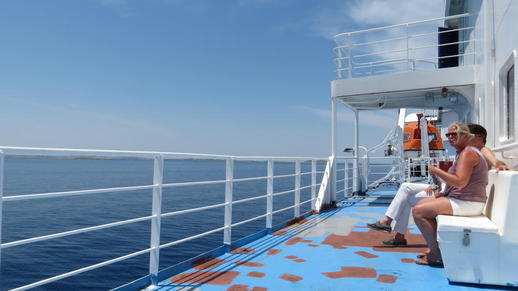
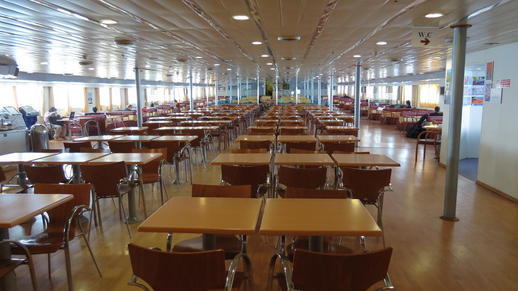
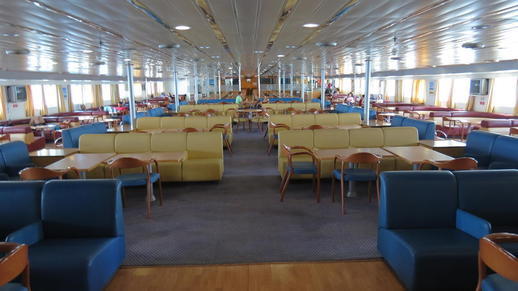
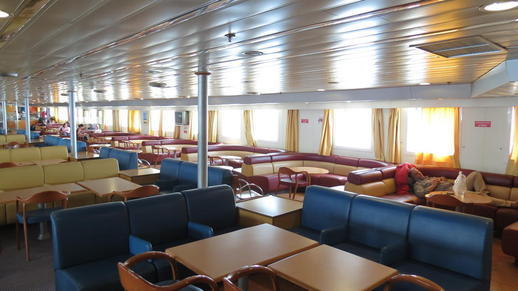
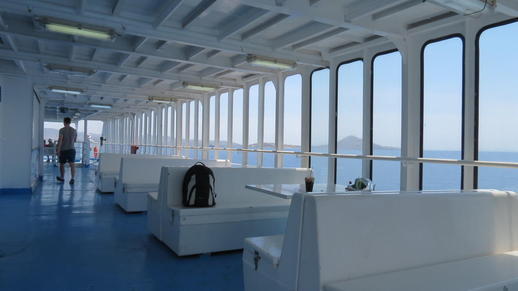

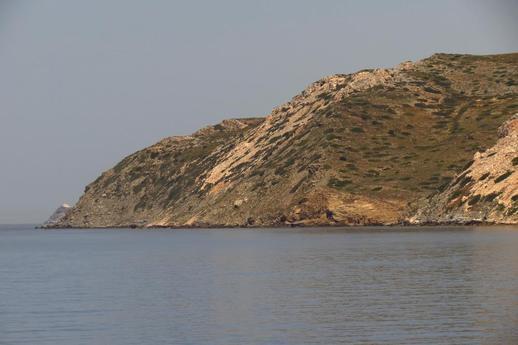
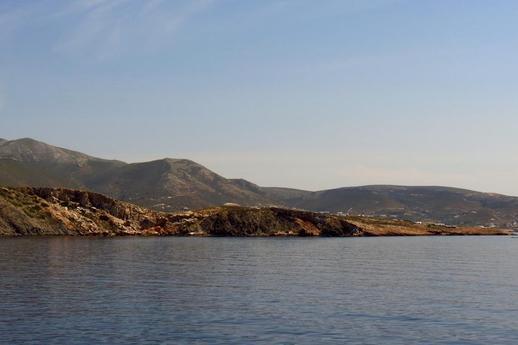

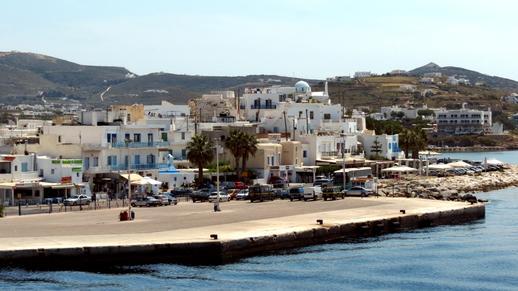
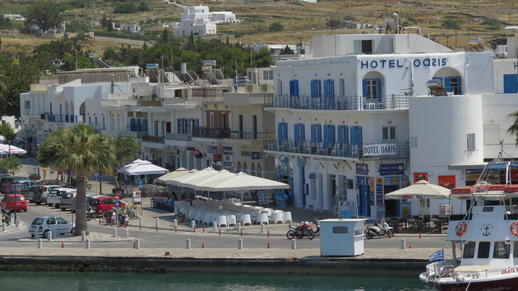
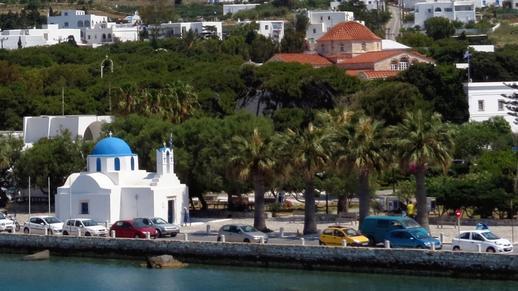


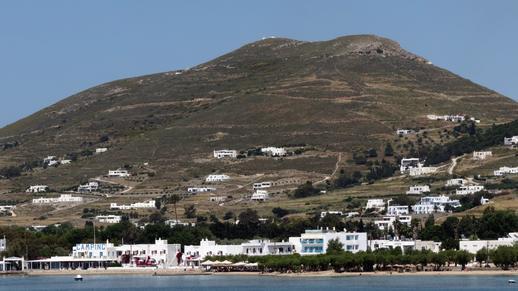
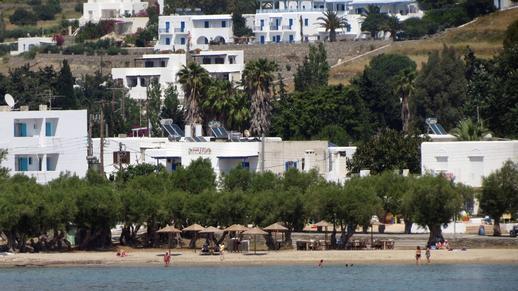


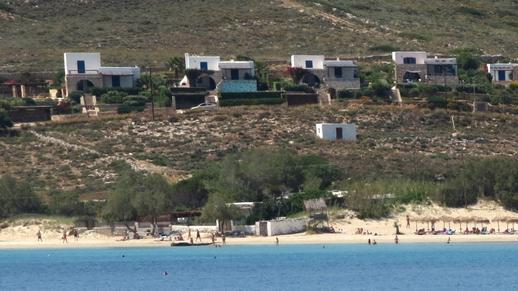
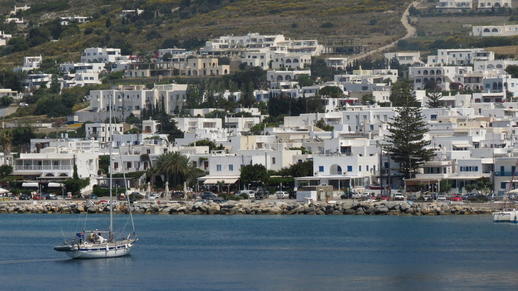
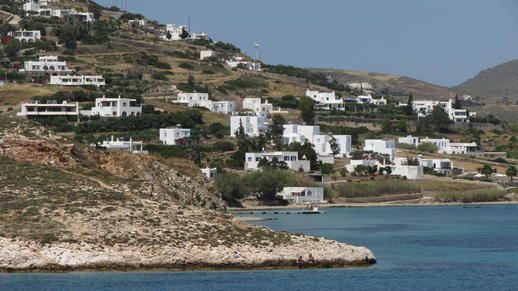
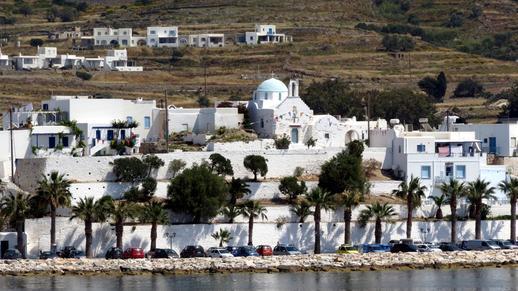
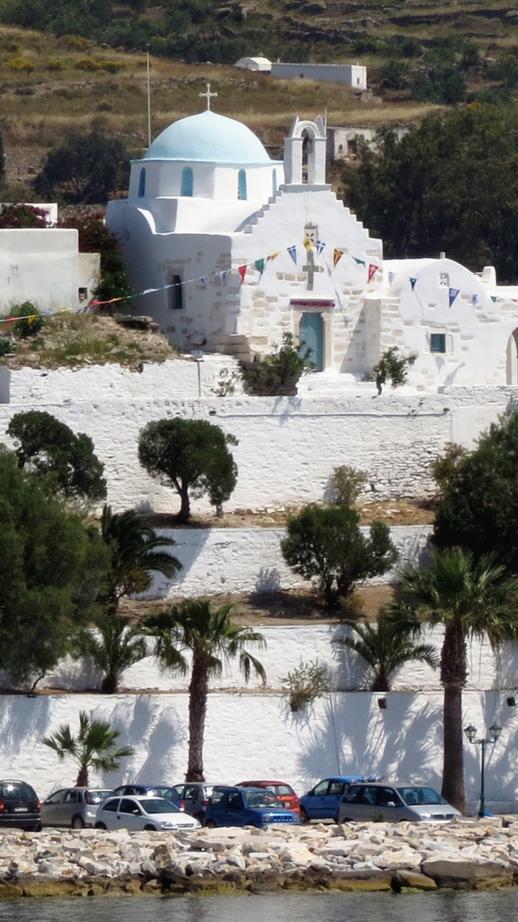
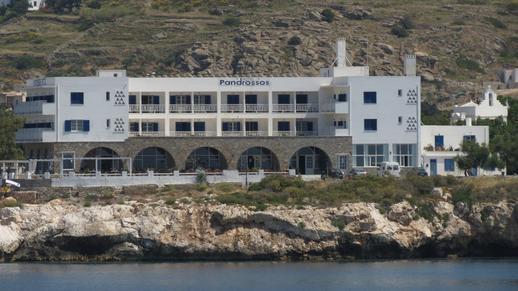
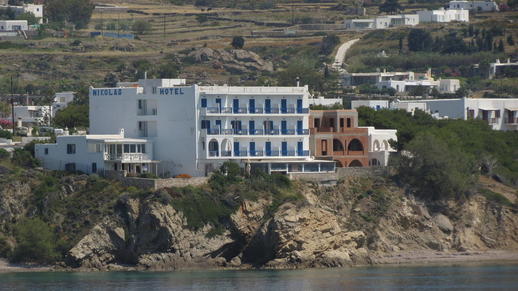
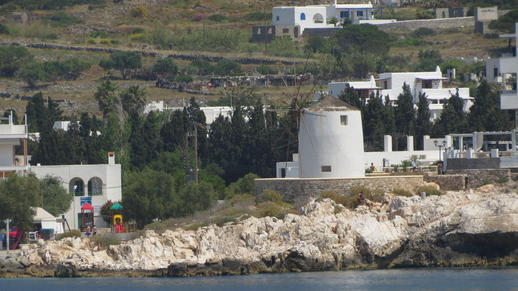
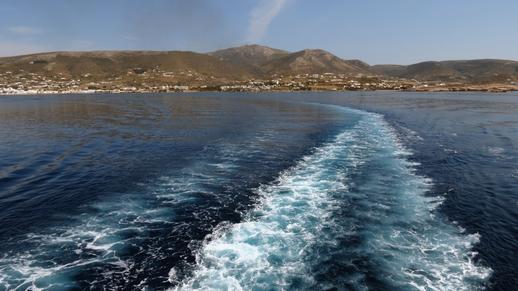





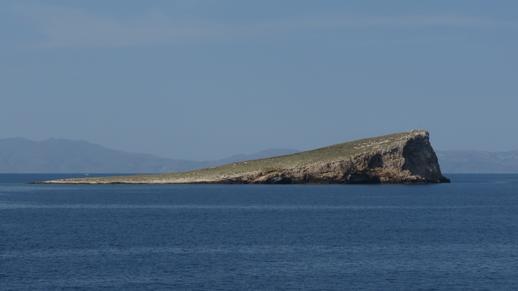

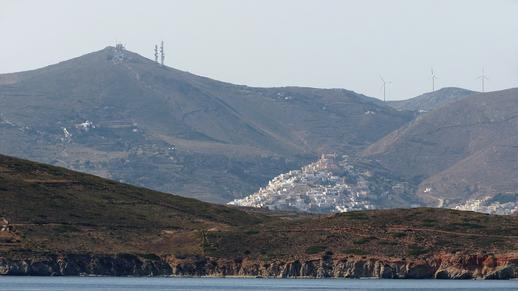
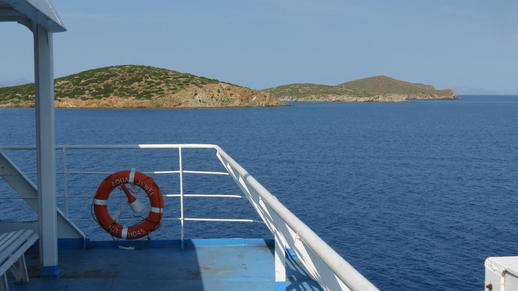
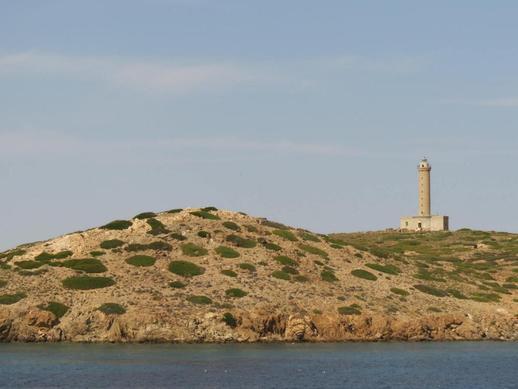
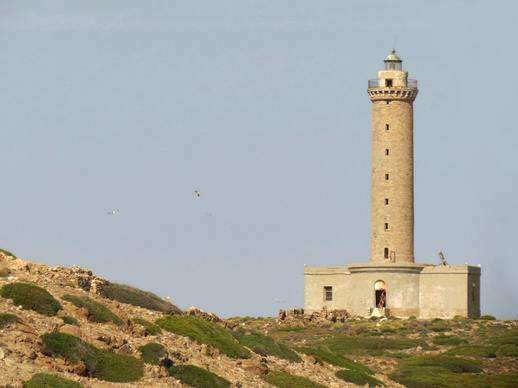
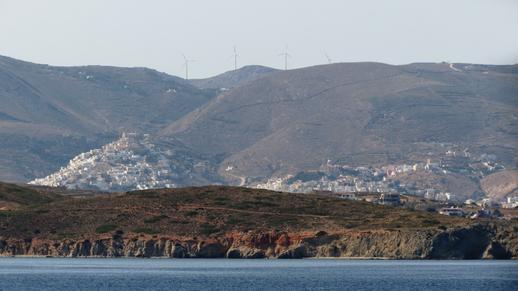


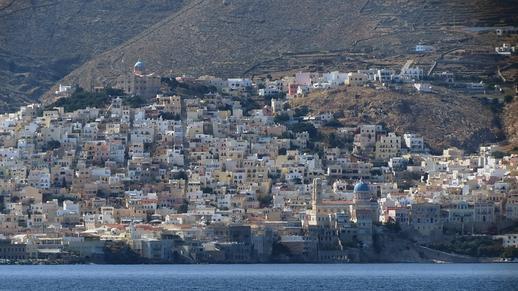




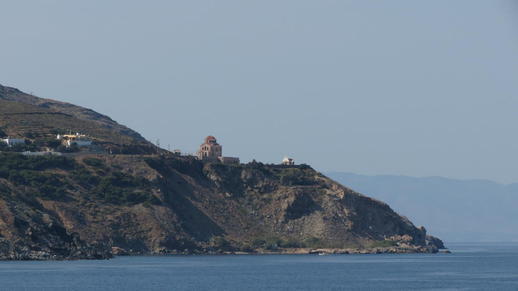
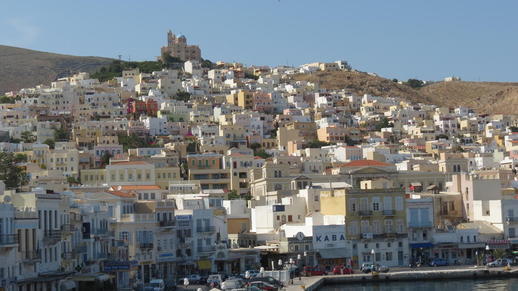
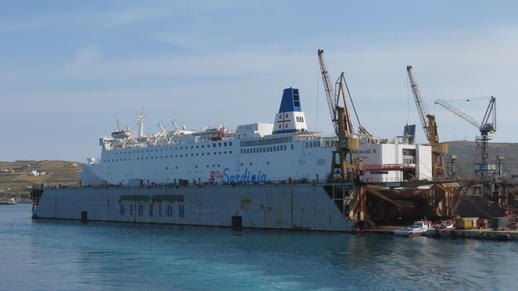


Leave a Reply